service schedule Citroen C5 2016 (RD/TD) / 2.G Owner's Manual
[x] Cancel search | Manufacturer: CITROEN, Model Year: 2016, Model line: C5, Model: Citroen C5 2016 (RD/TD) / 2.GPages: 366, PDF Size: 30.93 MB
Page 15 of 366
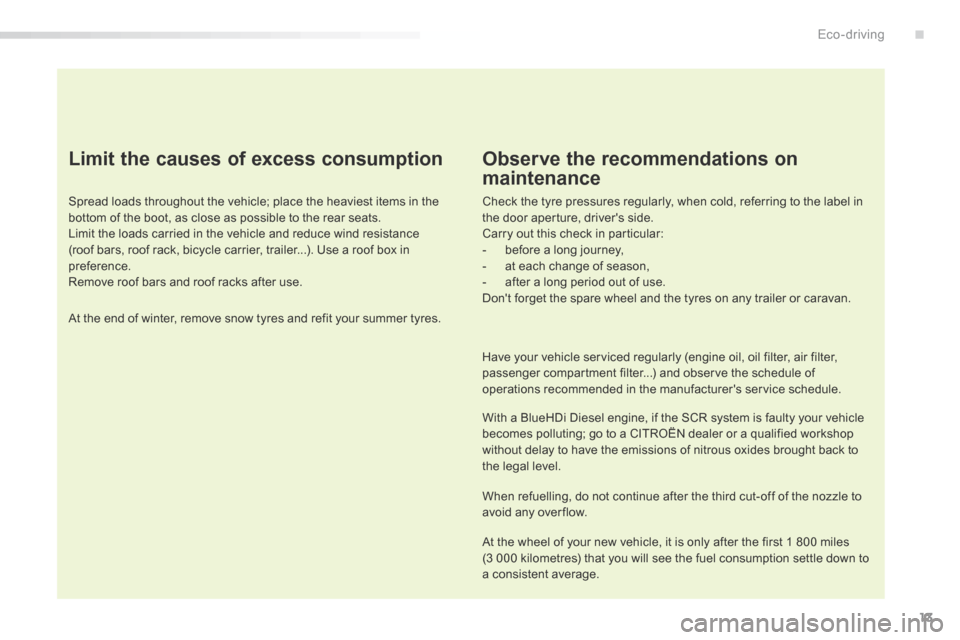
13
C5_en_Chap00c_eco-conduite_ed01-2015
Limit the causes of excess consumption
Spread loads throughout the vehicle; place the heaviest items in the
bottom of the boot, as close as possible to the rear seats.
Limit the loads carried in the vehicle and reduce wind resistance
(roof bars, roof rack, bicycle carrier, trailer...). Use a roof box in
preference.
Remove roof bars and roof racks after use.
At the end of winter, remove snow tyres and refit your summer tyres.
Observe the recommendations on
maintenance
Check the tyre pressures regularly, when cold, referring to the label in
the door aperture, driver's side.
Carry out this check in particular:
- before a long journey,
- at each change of season,
- after a long period out of use.
Don't forget the spare wheel and the tyres on any trailer or caravan.
Have your vehicle serviced regularly (engine oil, oil filter, air filter,
passenger compartment filter...) and observe the schedule of
operations recommended in the manufacturer's service schedule.
With a BlueHDi Diesel engine, if the SCR system is faulty your vehicle
becomes polluting; go to a CITROËN dealer or a qualified workshop
without delay to have the emissions of nitrous oxides brought back to
the legal level.
When refuelling, do not continue after the third cut-off of the nozzle to
avoid any over flow.
At the wheel of your new vehicle, it is only after the first 1 800 miles
(3 000 kilometres) that you will see the fuel consumption settle down to
a consistent average.
.
Eco-driving
Page 24 of 366
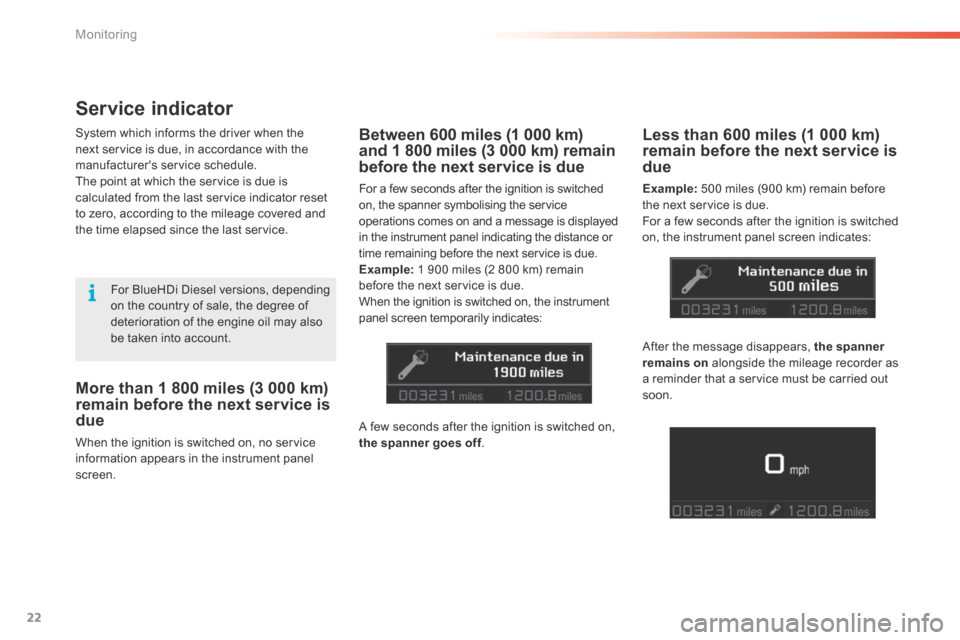
22
C5_en_Chap01_controle-de-marche_ed01-2015
More than 1 800 miles (3 000 km)
remain before the next service is
due
When the ignition is switched on, no service
information appears in the instrument panel
screen.
Between 600 miles (1 000 km)
and 1 800 miles (3 000 km) remain
before the next service is due
For a few seconds after the ignition is switched
on, the spanner symbolising the service
operations comes on and a message is displayed
in the instrument panel indicating the distance or
time remaining before the next service is due.
Example: 1 900 miles (2 800 km) remain
before the next service is due.
When the ignition is switched on, the instrument
panel screen temporarily indicates:
Less than 600 miles (1 000 km)
remain before the next service is
due
Example: 500 miles (900 km) remain before
the next service is due.
For a few seconds after the ignition is switched
on, the instrument panel screen indicates:
After the message disappears, the spanner
remains on alongside the mileage recorder as
a reminder that a service must be carried out
soon.
Service indicator
System which informs the driver when the
next service is due, in accordance with the
manufacturer's service schedule.
The point at which the service is due is
calculated from the last service indicator reset
to zero, according to the mileage covered and
the time elapsed since the last service.
A few seconds after the ignition is switched on,
the spanner goes off.
For BlueHDi Diesel versions, depending
on the country of sale, the degree of
deterioration of the engine oil may also
be taken into account.
Monitoring
Page 25 of 366
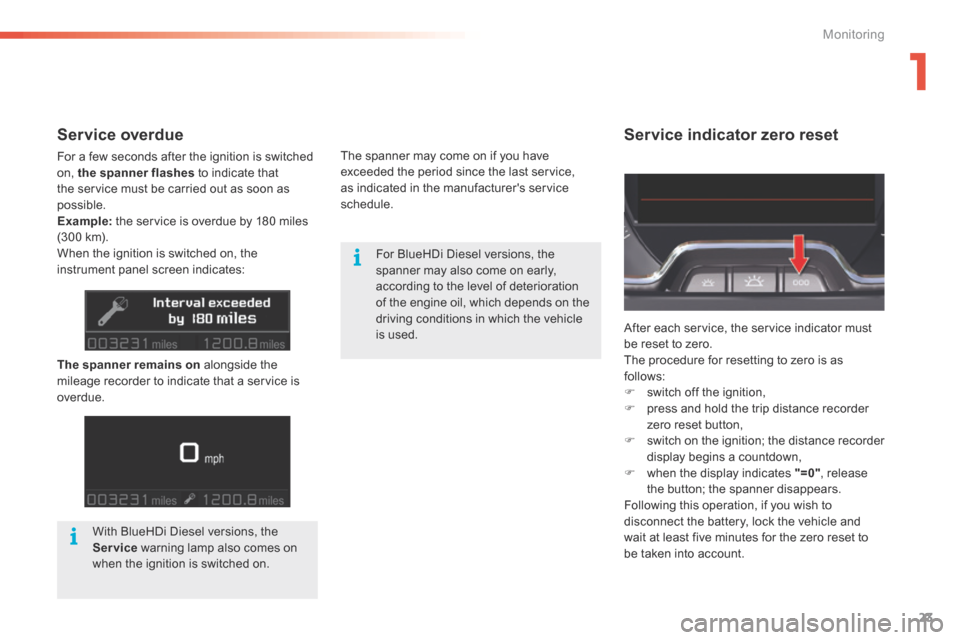
23
C5_en_Chap01_controle-de-marche_ed01-2015
Service indicator zero resetService overdue
For a few seconds after the ignition is switched
on, the spanner flashes to indicate that
the service must be carried out as soon as
possible.
Example: the service is overdue by 180 miles
(300 km).
When the ignition is switched on, the
instrument panel screen indicates:
The spanner remains on alongside the
mileage recorder to indicate that a service is
overdue. For b
lueHdi d iesel versions, the
spanner may also come on early,
according to the level of deterioration
of the engine oil, which depends on the
driving conditions in which the vehicle
is used. After each service, the service indicator must
be reset to zero.
The procedure for resetting to zero is as
follows:
F
switch off the ignition,
F press and hold the trip distance recorder
zero reset button,
F switch on the ignition; the distance recorder
display begins a countdown,
F when the display indicates "=0" , release
the button; the spanner disappears.
Following this operation, if you wish to
disconnect the battery, lock the vehicle and
wait at least five minutes for the zero reset to
be taken into account.
With b
lueHdi d iesel versions, the
Service warning lamp also comes on
when the ignition is switched on. The spanner may come on if you have
exceeded the period since the last service,
as indicated in the manufacturer's service
schedule.
1
Monitoring
Page 229 of 366
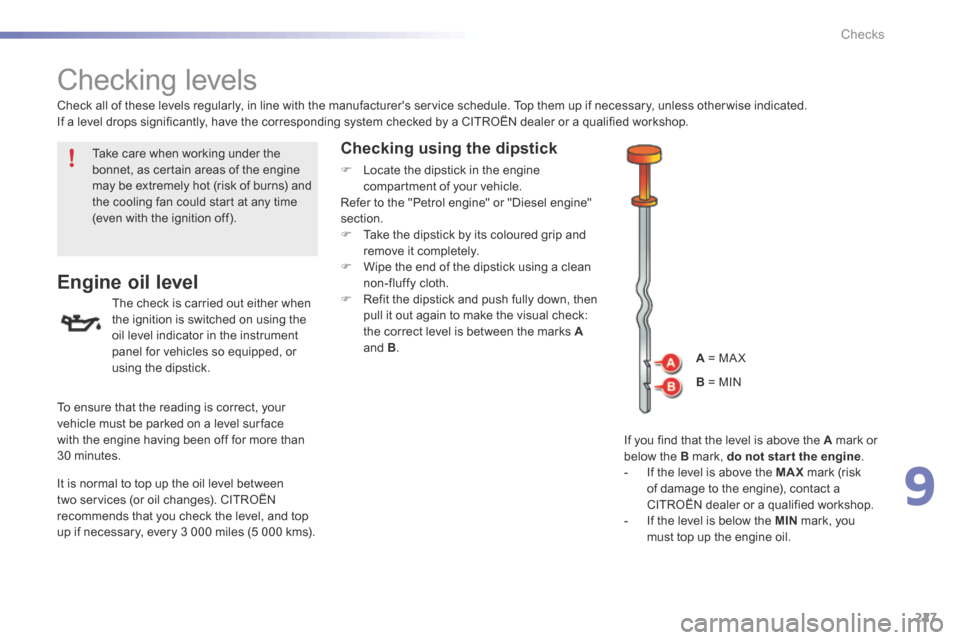
227
C5_en_Chap09_verification_ed01-2015
Checking levels
Engine oil level
The check is carried out either when
the ignition is switched on using the
oil level indicator in the instrument
panel for vehicles so equipped, or
using the dipstick.
Check all of these levels regularly, in line with the manufacturer's service schedule. Top them up if necessary, unless other wise indicated.
If a level drops significantly, have the corresponding system checked by a CITROËN dealer or a qualified workshop.
If you find that the level is above the A mark or
below the B mark, do not star t the engine.
- If the level is above the MAX mark (risk
of damage to the engine), contact a
CITROËN dealer or a qualified workshop.
- If the level is below the MIN mark, you
must top up the engine oil.
Take care when working under the
bonnet, as certain areas of the engine
may be extremely hot (risk of burns) and
the cooling fan could start at any time
(even with the ignition off).
To ensure that the reading is correct, your
vehicle must be parked on a level sur face
with the engine having been off for more than
30 minutes.
It is normal to top up the oil level between
two services (or oil changes). CITROËN
recommends that you check the level, and top
up if necessary, every 3 000 miles (5 000 kms).
Checking using the dipstick
F Locate the dipstick in the engine
compartment of your vehicle.
Refer to the "Petrol engine" or "Diesel engine"
section.
F Take the dipstick by its coloured grip and
remove it completely.
F Wipe the end of the dipstick using a clean
non-fluffy cloth.
F Refit the dipstick and push fully down, then
pull it out again to make the visual check:
the correct level is between the marks A
and B .
A = MaX
B = MI n
9
Checks
Page 230 of 366
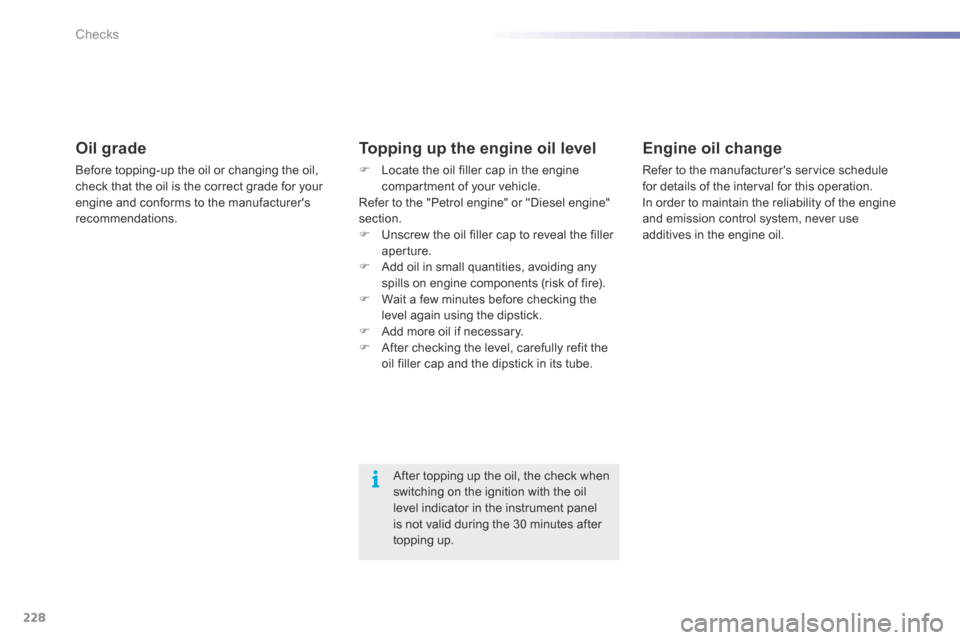
228
C5_en_Chap09_verification_ed01-2015
Oil grade
Before topping-up the oil or changing the oil,
check that the oil is the correct grade for your
engine and conforms to the manufacturer's
recommendations.
Topping up the engine oil level
F Locate the oil filler cap in the engine
compartment of your vehicle.
Refer to the "Petrol engine" or "Diesel engine"
section.
F Unscrew the oil filler cap to reveal the filler
aperture.
F Add oil in small quantities, avoiding any
spills on engine components (risk of fire).
F Wait a few minutes before checking the
level again using the dipstick.
F Add more oil if necessary.
F After checking the level, carefully refit the
oil filler cap and the dipstick in its tube.
After topping up the oil, the check when
switching on the ignition with the oil
level indicator in the instrument panel
is not valid during the 30 minutes after
topping up.
Engine oil change
Refer to the manufacturer's service schedule
for details of the interval for this operation.
In order to maintain the reliability of the engine
and emission control system, never use
additives in the engine oil.
Checks
Page 231 of 366
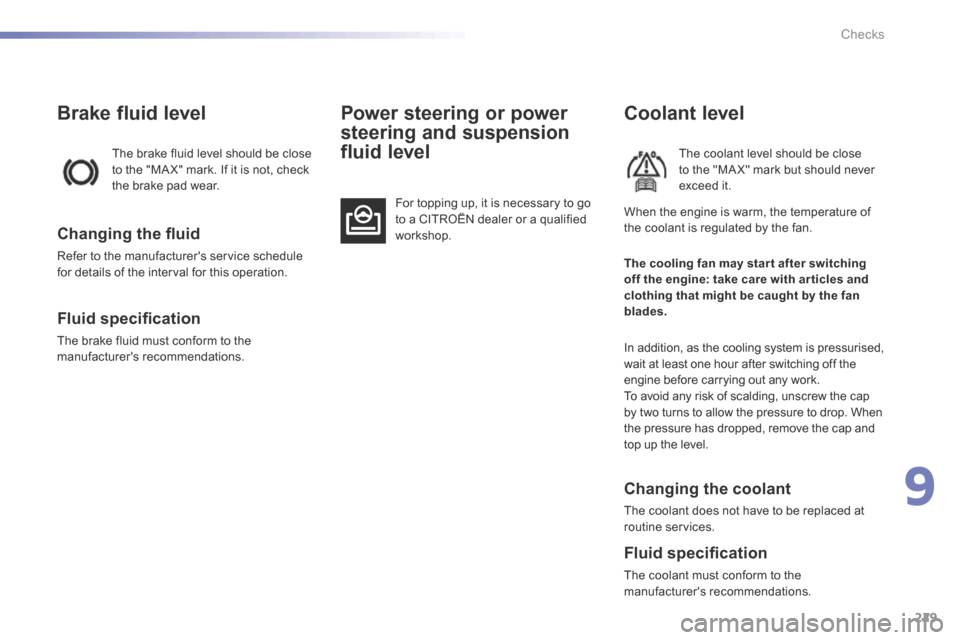
229
C5_en_Chap09_verification_ed01-2015
Brake fluid level
The brake fluid level should be close
to the "MA X" mark. If it is not, check
the brake pad wear.
Changing the fluid
Refer to the manufacturer's service schedule
for details of the interval for this operation.
Fluid specification
The brake fluid must conform to the
manufacturer's recommendations.
Power steering or power
steering and suspension
fluid level
For topping up, it is necessary to go
to a CITROËN dealer or a qualified
workshop.
Coolant level
The coolant level should be close
to the "MA X" mark but should never
exceed it.
Changing the coolant
The coolant does not have to be replaced at
routine services.
Fluid specification
The coolant must conform to the
manufacturer's recommendations. The cooling fan may star t after switching
off the engine: take care with ar ticles and
clothing that might be caught by the fan
blades.
In addition, as the cooling system is pressurised,
wait at least one hour after switching off the
engine before carrying out any work.
To avoid any risk of scalding, unscrew the cap
by two turns to allow the pressure to drop. When
the pressure has dropped, remove the cap and
top up the level. When the engine is warm, the temperature of
the coolant is regulated by the fan.
9
Checks
Page 233 of 366
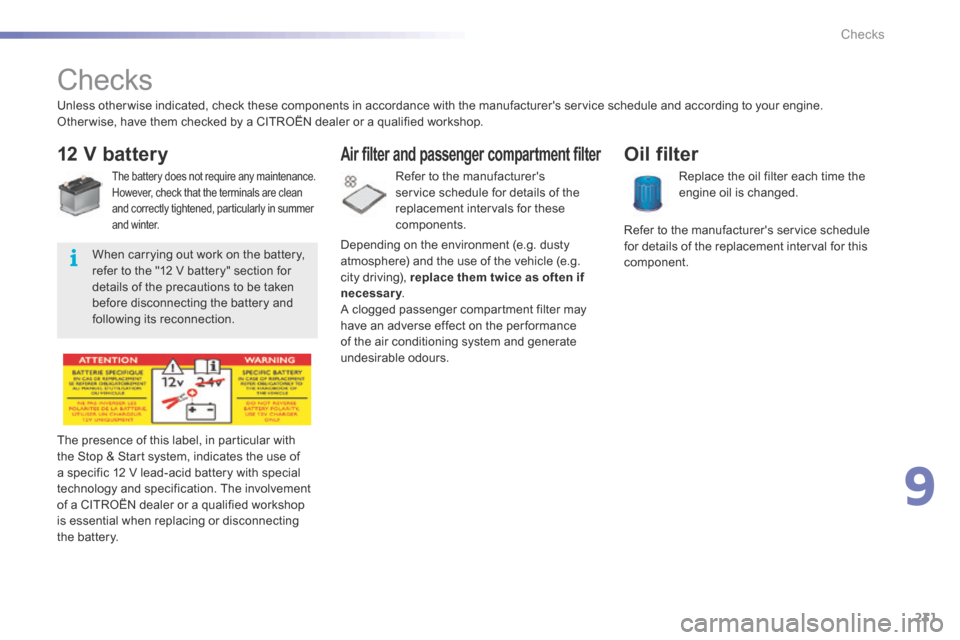
231
C5_en_Chap09_verification_ed01-2015
Checks
12 V battery
The battery does not require any maintenance.
However, check that the terminals are clean
and correctly tightened, particularly in summer
and winter.
The presence of this label, in particular with
the Stop & Start system, indicates the use of
a specific 12 V lead-acid battery with special
technology and specification. The involvement
of a CITROËN dealer or a qualified workshop
is essential when replacing or disconnecting
the battery. Unless other wise indicated, check these components in accordance with the manufacturer's service schedule and according to your engine.
Other wise, have them checked by a CITROËN dealer or a qualified workshop.
Air filter and passenger compartment filter
Depending on the environment (e.g. dusty
atmosphere) and the use of the vehicle (e.g.
city driving), replace them twice as often if
necessary.
A clogged passenger compartment filter may
have an adverse effect on the per formance
of the air conditioning system and generate
undesirable odours. Replace the oil filter each time the
engine oil is changed.
Oil filter
Refer to the manufacturer's service schedule
for details of the replacement interval for this
component.
Refer to the manufacturer's
service schedule for details of the
replacement intervals for these
components.
When carrying out work on the battery,
refer to the "12 V battery" section for
details of the precautions to be taken
before disconnecting the battery and
following its reconnection.
9
Checks
Page 234 of 366
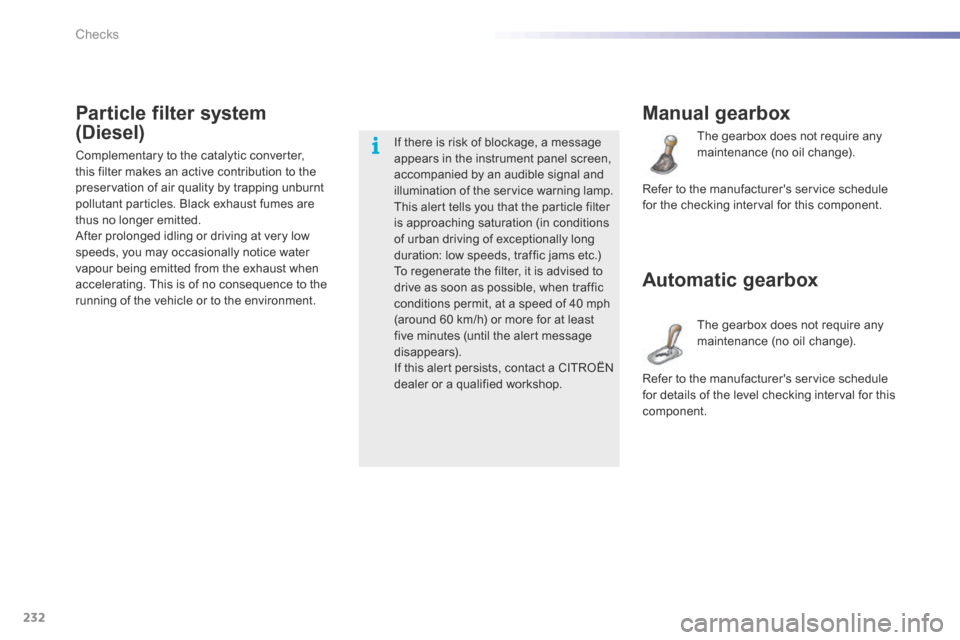
232
C5_en_Chap09_verification_ed01-2015
Manual gearbox
The gearbox does not require any
maintenance (no oil change).
Automatic gearbox
The gearbox does not require any
maintenance (no oil change).
Refer to the manufacturer's service schedule
for the checking interval for this component.
Refer to the manufacturer's service schedule
for details of the level checking interval for this
component.
Particle filter system
(Diesel)
Complementary to the catalytic converter,
this filter makes an active contribution to the
preservation of air quality by trapping unburnt
pollutant particles. Black exhaust fumes are
thus no longer emitted.
After prolonged idling or driving at very low
speeds, you may occasionally notice water
vapour being emitted from the exhaust when
accelerating. This is of no consequence to the
running of the vehicle or to the environment. If there is risk of blockage, a message
appears in the instrument panel screen,
accompanied by an audible signal and
illumination of the service warning lamp.
This alert tells you that the particle filter
is approaching saturation (in conditions
of urban driving of exceptionally long
duration: low speeds, traffic jams etc.)
To regenerate the filter, it is advised to
drive as soon as possible, when traffic
conditions permit, at a speed of 40 mph
(around 60 km/h) or more for at least
five minutes (until the alert message
disappears).
If this alert persists, contact a CITR
oËn
dealer or a qualified workshop.
Checks
Page 236 of 366
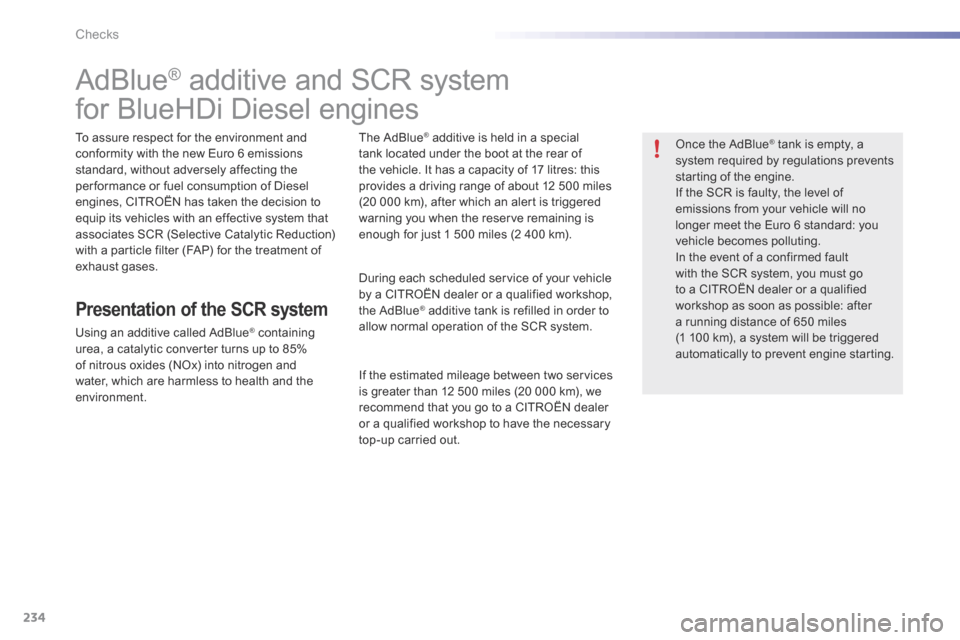
234
C5_en_Chap09_verification_ed01-2015
adb lue® additive and SCR system
for BlueHDi Diesel engines
To assure respect for the environment and
conformity with the new Euro 6 emissions
standard, without adversely affecting the
per formance or fuel consumption of Diesel
engines, CITROËN has taken the decision to
equip its vehicles with an effective system that
associates SCR (Selective Catalytic Reduction)
with a particle filter (FAP) for the treatment of
exhaust gases.
Presentation of the SCR system
Using an additive called AdBlue® containing
urea, a catalytic converter turns up to 85%
of nitrous oxides (NOx) into nitrogen and
water, which are harmless to health and the
environment. The ad
blue
® additive is held in a special
tank located under the boot at the rear of
the vehicle. It has a capacity of 17 litres: this
provides a driving range of about 12 500 miles
(20 000 km), after which an alert is triggered
warning you when the reserve remaining is
enough for just 1 500 miles (2 400 km).
During each scheduled service of your vehicle
by a CITROËN dealer or a qualified workshop,
the ad blue
® additive tank is refilled in order to
allow normal operation of the SCR system.
If the estimated mileage between two services
is greater than 12 500 miles (20 000 km), we
recommend that you go to a CITROËN dealer
or a qualified workshop to have the necessary
top-up carried out. o
nce the a db lue
® tank is empty, a
system required by regulations prevents
starting of the engine.
If the SCR is faulty, the level of
emissions from your vehicle will no
longer meet the Euro 6 standard: you
vehicle becomes polluting.
In the event of a confirmed fault
with the SCR system, you must go
to a CITROËN dealer or a qualified
workshop as soon as possible: after
a running distance of 650 miles
(1 100 km), a system will be triggered
automatically to prevent engine starting.
Checks